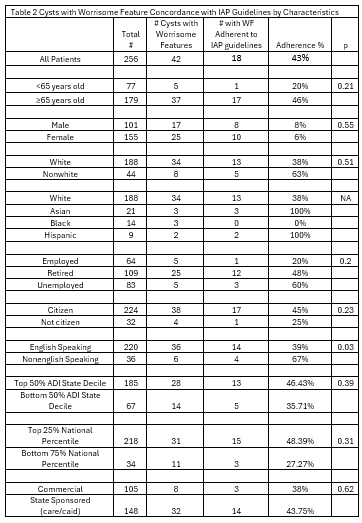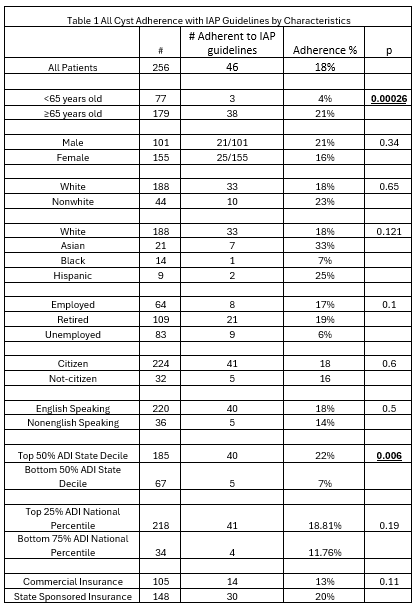Tuesday Poster Session
Category: Biliary/Pancreas
P4343 - Demographic and Socioeconomic Disparities in Surveillance of Newly Diagnosed Pancreatic Cysts
Tuesday, October 28, 2025
10:30 AM - 4:00 PM PDT
Location: Exhibit Hall

Daniel Marino, MD, MBA
NYU Langone Health
New York, NY
Presenting Author(s)
Daniel Marino, MD, MBA1, Prahan Chetlur, MD2, Kripali Gautam, MD1, Juan Cerezo, MD3, Kimberly Ho, MD4, Mahip Grewal, MD5, Aasma Shaukat, MD, MPH, FACG6, Tamas Gonda, MD1
1NYU Langone Health, New York, NY; 2NYU Langone, New York, NY; 3New York University Langone Health, New York, NY; 4Brown University / Warren Alpert Medical School, Providence, RI; 5Columbia University Irving Medical Center, New York, NY; 6NYU Grossman School of Medicine, Division of Gastroenterology and Hepatology, New York, NY
Introduction: The widespread use of abdominal imaging has increased the incidental detection of pancreatic cystic neoplasms (PCNs). The International Association of Pancreatology (IAP) has established guidelines for their evaluation. This study assessed how demographic and socioeconomic factors influence appropriate surveillance of newly diagnosed PCNs.
Methods: Using a validated algorithm, we identified all patients across our healthcare system with a newly discovered pancreatic cyst from January 2018 to April 2022. Exclusion criteria included known PCNs, nonneoplastic cysts, concomitant malignancy, cysts < 1 cm, and cysts detected during surveillance imaging. We collected data on age, sex, race, employment, U.S. citizenship, primary language, and insurance. Neighborhood adversity was measured using the Area Deprivation Index (ADI), reported by state decile and national percentile. Adherence to IAP guidelines was determined, and Chi-square tests evaluated differences across groups. Multivariable regression assessed predictors of adherence.
Results: A total of 256 patients were included; 42 cysts had worrisome features (WF). Table 1 shows the adherence with IAP guidelines across collected factors. Patients < 65 years were less adherent than those ≥65 (p=0.003), and individuals in the more deprived half of state ADI were less adherent than those in the less deprived half (p=0.006). Table 2 shows a subgroup analysis of cysts with WF. In the WF subgroup, there were no significant differences in adherence by any characteristics. In multivariable regression, age ≥65 was associated with increased adherence (OR 4.68, 95% CI: 1.3–18.8), while age < 65 was linked to decreased adherence (OR 0.21, 95% CI: 0.06–0.77). No other demographic or socioeconomic factor significantly predicted adherence in the full or WF only groups.
Discussion: Our results suggest that patients under 65 are less likely to receive guideline concordant surveillance, possibly due to lower healthcare engagement or awareness. Additionally, individuals in more disadvantaged states (higher ADI) are less likely to adhere, highlighting the influence of social determinants of health. Reassuringly, adherence in the WF subgroup did not vary by demographic or socioeconomic status, indicating that higher-risk patients are being appropriately followed. The lack of associations with other factors may be due to sample size limitations or population homogeneity.

Figure: Table 1. All Cyst Adherence with IAP Guidelines by Characteristics

Figure: Table 2. Cysts with Worrisome Feature Concordance with IAP Guidelines by Characteristics
Disclosures:
Daniel Marino indicated no relevant financial relationships.
Prahan Chetlur indicated no relevant financial relationships.
Kripali Gautam indicated no relevant financial relationships.
Juan Cerezo indicated no relevant financial relationships.
Kimberly Ho indicated no relevant financial relationships.
Mahip Grewal indicated no relevant financial relationships.
Aasma Shaukat: Freenome inc – Consultant.
Tamas Gonda indicated no relevant financial relationships.
Daniel Marino, MD, MBA1, Prahan Chetlur, MD2, Kripali Gautam, MD1, Juan Cerezo, MD3, Kimberly Ho, MD4, Mahip Grewal, MD5, Aasma Shaukat, MD, MPH, FACG6, Tamas Gonda, MD1. P4343 - Demographic and Socioeconomic Disparities in Surveillance of Newly Diagnosed Pancreatic Cysts, ACG 2025 Annual Scientific Meeting Abstracts. Phoenix, AZ: American College of Gastroenterology.
1NYU Langone Health, New York, NY; 2NYU Langone, New York, NY; 3New York University Langone Health, New York, NY; 4Brown University / Warren Alpert Medical School, Providence, RI; 5Columbia University Irving Medical Center, New York, NY; 6NYU Grossman School of Medicine, Division of Gastroenterology and Hepatology, New York, NY
Introduction: The widespread use of abdominal imaging has increased the incidental detection of pancreatic cystic neoplasms (PCNs). The International Association of Pancreatology (IAP) has established guidelines for their evaluation. This study assessed how demographic and socioeconomic factors influence appropriate surveillance of newly diagnosed PCNs.
Methods: Using a validated algorithm, we identified all patients across our healthcare system with a newly discovered pancreatic cyst from January 2018 to April 2022. Exclusion criteria included known PCNs, nonneoplastic cysts, concomitant malignancy, cysts < 1 cm, and cysts detected during surveillance imaging. We collected data on age, sex, race, employment, U.S. citizenship, primary language, and insurance. Neighborhood adversity was measured using the Area Deprivation Index (ADI), reported by state decile and national percentile. Adherence to IAP guidelines was determined, and Chi-square tests evaluated differences across groups. Multivariable regression assessed predictors of adherence.
Results: A total of 256 patients were included; 42 cysts had worrisome features (WF). Table 1 shows the adherence with IAP guidelines across collected factors. Patients < 65 years were less adherent than those ≥65 (p=0.003), and individuals in the more deprived half of state ADI were less adherent than those in the less deprived half (p=0.006). Table 2 shows a subgroup analysis of cysts with WF. In the WF subgroup, there were no significant differences in adherence by any characteristics. In multivariable regression, age ≥65 was associated with increased adherence (OR 4.68, 95% CI: 1.3–18.8), while age < 65 was linked to decreased adherence (OR 0.21, 95% CI: 0.06–0.77). No other demographic or socioeconomic factor significantly predicted adherence in the full or WF only groups.
Discussion: Our results suggest that patients under 65 are less likely to receive guideline concordant surveillance, possibly due to lower healthcare engagement or awareness. Additionally, individuals in more disadvantaged states (higher ADI) are less likely to adhere, highlighting the influence of social determinants of health. Reassuringly, adherence in the WF subgroup did not vary by demographic or socioeconomic status, indicating that higher-risk patients are being appropriately followed. The lack of associations with other factors may be due to sample size limitations or population homogeneity.

Figure: Table 1. All Cyst Adherence with IAP Guidelines by Characteristics

Figure: Table 2. Cysts with Worrisome Feature Concordance with IAP Guidelines by Characteristics
Disclosures:
Daniel Marino indicated no relevant financial relationships.
Prahan Chetlur indicated no relevant financial relationships.
Kripali Gautam indicated no relevant financial relationships.
Juan Cerezo indicated no relevant financial relationships.
Kimberly Ho indicated no relevant financial relationships.
Mahip Grewal indicated no relevant financial relationships.
Aasma Shaukat: Freenome inc – Consultant.
Tamas Gonda indicated no relevant financial relationships.
Daniel Marino, MD, MBA1, Prahan Chetlur, MD2, Kripali Gautam, MD1, Juan Cerezo, MD3, Kimberly Ho, MD4, Mahip Grewal, MD5, Aasma Shaukat, MD, MPH, FACG6, Tamas Gonda, MD1. P4343 - Demographic and Socioeconomic Disparities in Surveillance of Newly Diagnosed Pancreatic Cysts, ACG 2025 Annual Scientific Meeting Abstracts. Phoenix, AZ: American College of Gastroenterology.


